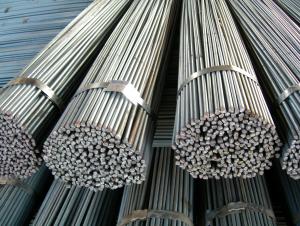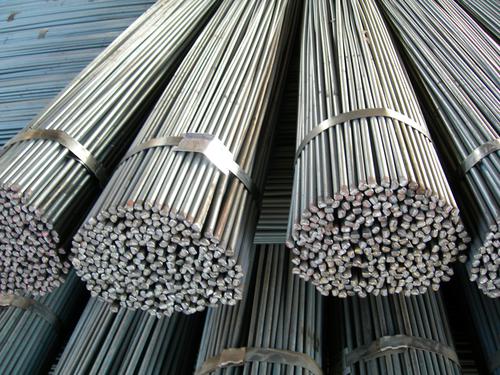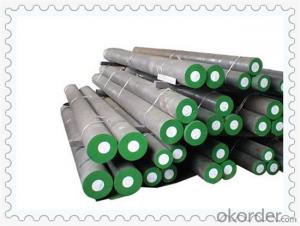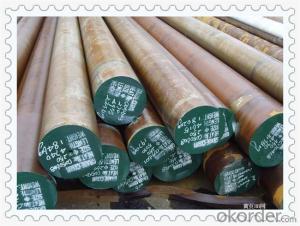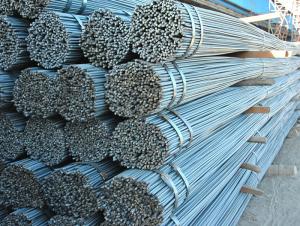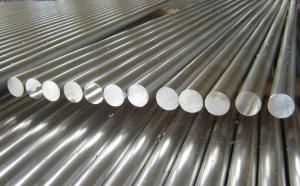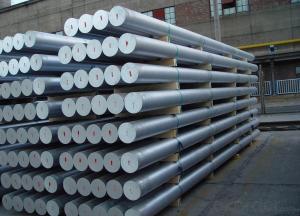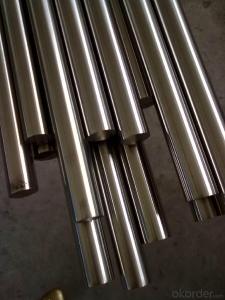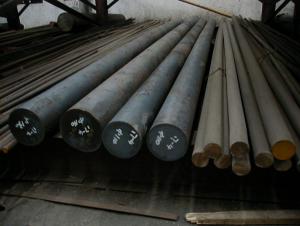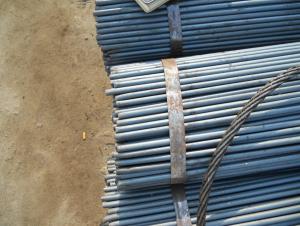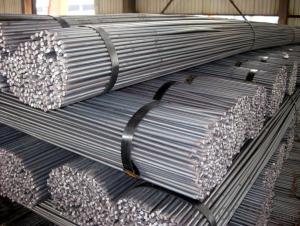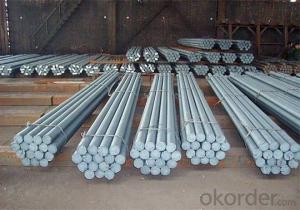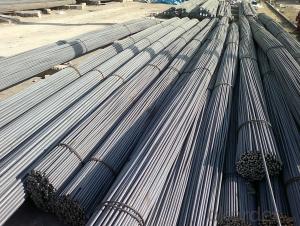Round Bar Q235 5MM-100MM Hot Rolled High Quality Q195
- Loading Port:
- China Main Port
- Payment Terms:
- TT or LC
- Min Order Qty:
- -
- Supply Capability:
- -
OKorder Service Pledge
OKorder Financial Service
You Might Also Like
Product Description:
OKorder is offering Round Bar Q235 5MM-100MM Hot Rolled High Quality Q195 at great prices with worldwide shipping. Our supplier is a world-class manufacturer of steel, with our products utilized the world over. OKorder annually supplies products to European, North American and Asian markets. We provide quotations within 24 hours of receiving an inquiry and guarantee competitive prices.
Product Applications:
1) Suitable for making various strong cutting tool abrasion resistance, impact resistance.
2) Used to produce all kinds of high hard and super hard saw blade, drill, tap, broach, gear hob and various kinds of milling cutter.
3) Used for advanced punching die, screw die, and the toughness and complicated shape of the punch, etc.
4) Is used for cold forging die and drawing mode, etc.
5) Recommended watchcase factory, screw factory and other cold stamping products industry use.
Product Advantages:
OKorder's Round Bar Q235 5MM-100MM Hot Rolled High Quality Q195 are durable, strong, and resist corrosion.
Main Product Features:
· Premium quality
· Prompt delivery & seaworthy packing (30 days after receiving deposit)
· Corrosion resistance
· Can be recycled and reused
· Mill test certification
· Professional Service
· Competitive pricing
Product Specifications:
1. Grade: GB, JIS, ASTM, EN
2. Grade: Q235, SS400, A36, S235JR
3. Diameter and mass: As below
Diameter | Mass | Diameter | Mass | Diameter | Mass |
(mm) | (kg/m) | (mm) | (kg/m) | (mm) | (kg/m) |
6 | 0.22 | 22 | 2.98 | 53 | 17.30 |
7 | 0.30 | 24 | 3.55 | 56 | 19.30 |
8 | 0.40 | 25 | 3.85 | 60 | 22.20 |
9 | 0.50 | 26 | 4.17 | 63 | 24.50 |
10 | 0.62 | 28 | 4.83 | 65 | 26.00 |
11 | 0.75 | 30 | 5.55 | 70 | 30.20 |
12 | 0.89 | 32 | 6.31 | 75 | 34.70 |
13 | 1.04 | 34 | 7.13 | 80 | 39.50 |
14 | 1.21 | 36 | 7.99 | 85 | 44.50 |
15 | 1.39 | 38 | 8.90 | 90 | 49.90 |
16 | 1.58 | 40 | 9.86 | 95 | 55.60 |
17 | 1.78 | 42 | 10.90 | 100 | 61.70 |
18 | 2.00 | 45 | 12.50 | 120 | 88.85 |
19 | 2.23 | 48 | 14.20 | 140 | 120.93 |
20 | 2.47 | 50 | 15.40 | 150 | 138.82 |
4. Material: Mild Steel
5. Heat treatment of high quality steel:
Fire: Isothermal annealing temperature is 800 ~ 880 °C, with 10 ~ 20 °C, the furnace cooling to about 600 °C, hardness above HB269.
Preheat temperature: 730-730 °C
Quenching temperature: 1190-1210 °C
Tempering temperature: 540-595 °C
Cold drawn, hardness 285 HBS
Cold drawn after annealing condition, hardness 277 HBS
Quenching methods: oil quenching, air cooling or salt bath quenching
FAQ:
Q1: Why buy Materials & Equipment from OKorder.com?
A1: All products offered byOKorder.com are carefully selected from China's most reliable manufacturing enterprises. Through its ISO certifications, OKorder.com adheres to the highest standards and a commitment to supply chain safety and customer satisfaction.
Q2: How do we guarantee the quality of our products?
A2: We have established an advanced quality management system which conducts strict quality tests at every step, from raw materials to the final product. At the same time, we provide extensive follow-up service assurances as required.
Q3: The products are invoicing on theoritical weight or on actual weight?
A3: We can do it in both manners, according to the customers' request.

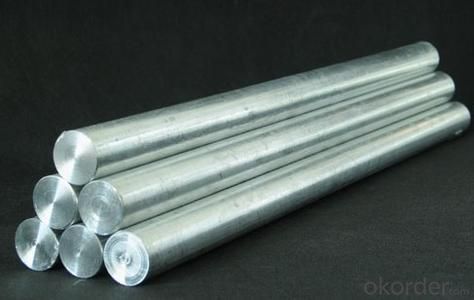
- Q: What is the difference between a rough turned and a hot rolled steel round bar?
- A rough turned steel round bar is a type of steel bar that has been partially machined to remove imperfections and excess material, leaving a rough surface finish. This process helps to refine the dimensions and shape of the bar, making it more accurate and consistent. On the other hand, a hot rolled steel round bar is a type of steel bar that has been heated to high temperatures and then passed through a series of rollers to achieve the desired shape and size. This process results in a smooth surface finish and provides a uniform grain structure, which enhances the strength and durability of the steel. In summary, the main difference between a rough turned and a hot rolled steel round bar lies in the surface finish and manufacturing process used to produce them.
- Q: What are the advantages of using duplex steel round bars?
- Duplex steel round bars offer numerous benefits for various applications. Firstly, they provide exceptional resistance to corrosion. By combining chromium, nickel, and molybdenum, this steel can withstand harsh conditions found in marine and chemical industries. This makes it ideal for high exposure to corrosive elements. Secondly, duplex steel round bars possess great strength and toughness. The unique microstructure of this steel, combining ferrite and austenite phases, results in greater strength compared to traditional stainless steels. This makes them suitable for demanding applications requiring high load-bearing capacities. Additionally, duplex steel round bars exhibit excellent fatigue resistance. This makes them perfect for applications subjected to cyclic loading or dynamic stress, such as structural components or machinery parts. Their fatigue resistance allows for extended service life and reliability. Another advantage of using duplex steel round bars is their superior weldability. Their balanced chemical composition and microstructure enable easy fabrication and joining, reducing production time and costs in various industries. Furthermore, duplex steel round bars demonstrate exceptional resistance to stress corrosion cracking (SCC). This makes them a preferred choice for applications with a high risk of SCC, such as offshore and oil and gas industries. Lastly, duplex steel round bars provide cost-effective solutions. Despite their superior properties, they are often more cost-effective than other high-performance materials. Their long service life, reduced maintenance requirements, and overall durability contribute to lower lifecycle costs, making them an economical choice for various applications. In conclusion, duplex steel round bars offer excellent corrosion resistance, high strength and toughness, good fatigue resistance, superior weldability, resistance to stress corrosion cracking, and cost-effectiveness. These properties make them a preferred choice for industries such as oil and gas, chemical processing, marine, and structural applications.
- Q: What are the advantages of using nickel-chromium-manganese alloy steel round bars?
- There are several advantages of using nickel-chromium-manganese alloy steel round bars in various applications. Firstly, this type of alloy steel offers excellent strength and durability. The combination of nickel, chromium, and manganese enhances the overall strength of the steel, making it resistant to wear, impact, and deformation. This is particularly beneficial in industries such as construction, manufacturing, and automotive, where the round bars are commonly used for structural support and load-bearing purposes. Secondly, nickel-chromium-manganese alloy steel round bars exhibit excellent corrosion resistance. The presence of nickel and chromium in the alloy composition makes it highly resistant to rust and oxidation, even in harsh environments or exposure to corrosive substances. This property is crucial in applications where the round bars are exposed to moisture, chemicals, or high temperatures, such as marine environments or chemical processing plants. Additionally, this type of alloy steel offers good weldability and machinability. The combination of nickel, chromium, and manganese provides a balanced composition that allows for easy welding and machining operations. This makes it convenient for fabricators and manufacturers to work with the round bars, enabling them to create complex shapes or structures without compromising the material's integrity. Moreover, nickel-chromium-manganese alloy steel round bars have excellent heat resistance. The presence of nickel and chromium in the alloy composition enhances its ability to withstand high temperatures without losing its strength or shape. This property makes it suitable for applications that involve exposure to extreme heat, such as furnace components, heat exchangers, or high-temperature industrial processes. Lastly, the use of nickel-chromium-manganese alloy steel round bars often leads to cost savings in the long run. Due to their exceptional strength and durability, these round bars have a longer lifespan compared to other materials. This reduces the need for frequent replacements, resulting in lower maintenance costs and improved overall efficiency. In conclusion, the advantages of using nickel-chromium-manganese alloy steel round bars include excellent strength and durability, corrosion resistance, weldability, machinability, heat resistance, and long-term cost savings. These properties make them a preferred choice in various industries where high-performance materials are required.
- Q: What is the maximum silicon content allowed for steel round bars?
- The maximum silicon content allowed for steel round bars is typically around 0.35%.
- Q: How are steel round bars manufactured?
- Hot rolling is the method utilized to produce steel round bars. The process begins with heating a large steel billet in a furnace until it becomes soft and malleable. Subsequently, the billet is passed through a series of rollers, which compress and shape it into a round bar. The initial step in hot rolling is the roughing mill, where the billet is subjected to multiple sets of rollers to reduce its thickness and increase its length. This step ensures that the steel maintains a consistent temperature throughout. Following the roughing mill, the bar enters the finishing mill, where it undergoes further size reduction and acquires its final shape. The finishing mill typically comprises several sets of rollers that gradually decrease the bar's diameter while increasing its length. This process is repeated until the desired dimensions are attained. Throughout the rolling process, rigorous quality control measures are implemented to continuously monitor the steel round bar. Any imperfections or defects that arise are promptly identified and rectified to ensure the final product adheres to the required specifications. Once the bar reaches its final dimensions, it is cooled and cut to the desired length. The cooling process can be achieved through the use of air, water, or a combination of both. Subsequently, the bar is inspected for any surface defects and may undergo further processing if needed. In certain cases, additional treatments such as heat treatment or surface finishing may be employed to enhance the properties and appearance of the steel round bar. In conclusion, the manufacturing of steel round bars involves a combination of heating, rolling, cooling, and cutting processes. These procedures are meticulously executed to yield a superior product that fulfills the specific requirements of diverse industries.
- Q: What is the difference between a rough turned and a centerless ground steel round bar?
- A rough turned steel round bar is a steel bar that has been machined to a standard size and shape using a lathe or turning machine. This involves removing excess material from the bar's surface to achieve the desired diameter and smoothness. The resulting rough turned bar may still have minor imperfections or variations in size and surface finish. On the contrary, a centerless ground steel round bar undergoes a different manufacturing process. This process involves feeding the steel bar through two rotating wheels - a grinding wheel and a regulating wheel. The grinding wheel removes material from the bar's surface to achieve a precise diameter, while the regulating wheel controls the bar's feed rate. This process ensures precise tolerances, an excellent surface finish, and a consistent diameter along the entire length of the bar. In conclusion, the primary distinction between a rough turned and a centerless ground steel round bar lies in the manufacturing process and resulting quality. While a rough turned bar is machined to a standard size and shape with some imperfections, a centerless ground bar undergoes a more precise grinding process to achieve a highly accurate diameter, excellent surface finish, and consistent dimensions throughout the bar.
- Q: Can steel round bars be used in the production of machinery?
- Yes, steel round bars can be used in the production of machinery. Steel round bars are commonly used in the manufacturing industry for various applications, including the production of machinery. The high strength and durability of steel make it an ideal material for constructing machine components that require strength and rigidity. Steel round bars can be machined, shaped, and welded to create different parts such as shafts, gears, axles, and structural components in machinery. The use of steel round bars ensures the reliability and longevity of the machinery, making it a preferred choice in many industries.
- Q: Is there a steel bar of 6 diameter on the market?
- There is no rebar of 6 diameter on the market.
- Q: What are the different marking methods for steel round bars?
- There are several marking methods commonly used for steel round bars. These methods are used to identify and provide information about the steel bars, such as their specifications, grades, manufacturer, and other relevant details. 1. Stamping: Stamping is a widely used marking method in which information is imprinted onto the surface of the steel round bar using a stamping machine. This can include alphanumeric characters, symbols, or logos. Stamping provides a permanent and durable marking that is resistant to wear and corrosion. 2. Laser Marking: Laser marking is a precise and high-quality marking method that uses a laser beam to engrave information onto the surface of the steel round bar. This method allows for intricate designs, barcodes, and serial numbers to be marked. Laser marking provides permanent identification that is resistant to fading and tampering. 3. Inkjet Printing: Inkjet printing is a non-contact marking method that uses inkjet technology to print information onto the steel round bar's surface. This method is commonly used for marking barcodes, QR codes, and other data matrix codes. Inkjet printing allows for fast and efficient marking, and the ink used is designed to adhere to the steel surface effectively. 4. Etching: Etching is a chemical marking method that involves using acid or other chemicals to remove layers of the steel round bar's surface, creating a visible mark. This method is commonly used for marking logos, identification numbers, or other designs. Etching provides a permanent marking that can be easily read and is resistant to wear. 5. Color Coding: Color coding is a simple marking method that involves using paint or colored coatings to mark different types or grades of steel round bars. Each color represents a specific attribute or characteristic, such as strength, corrosion resistance, or heat resistance. Color coding provides quick and visual identification of the steel round bars. These marking methods play a crucial role in ensuring proper identification, traceability, and quality control of steel round bars in various industries such as construction, manufacturing, and engineering. The choice of marking method depends on factors such as the required level of permanence, visibility, and the specific information to be marked on the steel round bars.
- Q: How are steel round bars made?
- Hot rolling is the method used to produce steel round bars. It starts by heating a large rectangular steel billet until it becomes malleable. Then, the heated billet is fed through a series of rolling stands that gradually decrease its thickness and give it a round shape. To begin the hot rolling process, the billet is placed in a furnace and subjected to extremely high temperatures, typically ranging from 1200 to 1300 degrees Celsius. This high heat makes the steel more pliable and easier to manipulate. Once the billet is heated, it is introduced into a rolling mill. This mill consists of rollers that progressively reduce the thickness and elongate the billet. Each set of rollers squeezes and stretches the billet, gradually forming it into a round shape. The number of passes through the rolling mill depends on the desired final size and shape of the round bar. While the rolling process takes place, the steel bar is also cooled to prevent overheating and ensure proper metallurgical properties. This cooling can be achieved through the use of a water spray or air cooling system. After the bar has been shaped and cooled, it is cut into the desired lengths. The cut bars then undergo further processes, including straightening, surface treatment, and quality testing. These additional steps guarantee that the steel round bars meet the required specifications and standards. In conclusion, the production of steel round bars involves heating a steel billet, passing it through a series of rolling stands to shape it into a round bar, cooling it, and cutting it into the desired lengths. This process enables the creation of robust and long-lasting round bars that serve various applications in industries like construction, manufacturing, and engineering.
Send your message to us
Round Bar Q235 5MM-100MM Hot Rolled High Quality Q195
- Loading Port:
- China Main Port
- Payment Terms:
- TT or LC
- Min Order Qty:
- -
- Supply Capability:
- -
OKorder Service Pledge
OKorder Financial Service
Similar products
Hot products
Hot Searches
